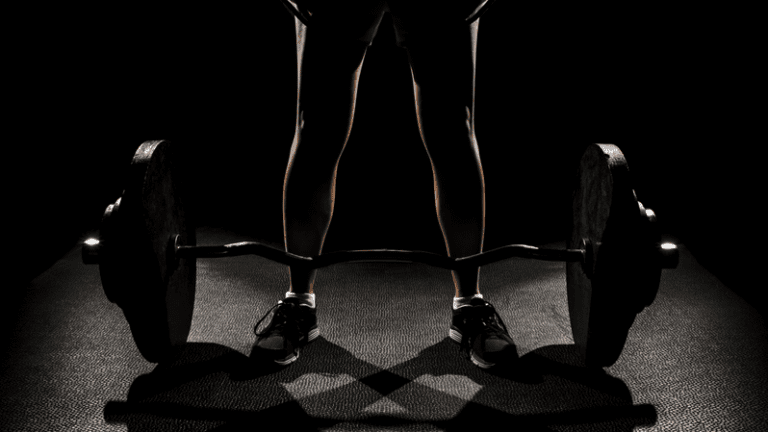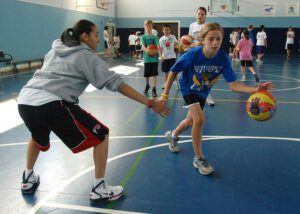Developing Power Using the Hang Clean
Olympic lifts are often a lightning rod for discussion when it comes to how to best develop power. There are those that feel that the return is not worth the investment required in regards to teaching time and risk of injury. There are those that feel anything other than Olympic lifts is a waste of time and nothing compares to the power development developed from these movements. From my experience in training athletes I have found that Olympic lifts are a big piece of the puzzle. They are not the puzzle, and gains in power can be made without them. However, there is too much data too completely disregard the benefit of Olympic lifts. In addition there is plenty of empirical evidence that favors the side that believes Olympic lifts can aid in athletic development.
When testing Olympic athletes, Olympic lifters will always have some of the highest vertical jumps of all the athletes. In addition Olympic throwers always perform Olympic movements in their weight training. Athletes will benefit from lifts such as the hang clean due to the triple extensions that occurs when applying force into the ground. The speed of the bar is hard to mimic with other movements. The benefit of rate of force development will aid in acceleration, linear speed (increase in stride length), vertical jumping abilities and change of direction. There is also the balance and body control component being developed when catching the weight during Olympic lifts. This portion of the lift helps athletes in decelerating and coordinating upper and lower body movements.
Like any lift, when taught properly and performed with good technique, there is no dangerous lifts – just dangerous technique. When first teaching athletes how to perform Olympic movements we begin with a PVC pipe.
Reps are performed in the 6 and under range so that the lifter can maintain both bar speed and great technique. **rep ranges for power development** If one were able to use a device such as a Tendo unit to measure the speed of the bar on a lift, I can’t imagine that the 5oth rep would produce anywhere near the power that the 3rd-6th rep did during that set.
When performing Olympic lifts in your workout it is best to perform them first in your workouts, due to the amount of power and technical demands. Exceptions can be made when doing partial movements such as a hang clean pull or a DB Clean (as seen in the Tier System Example).
Teaching Progression:
1. Hang Clean Pull
2. Hang Clean High Pull
3. Hang Clean
The Hang Clean Pull:
This is just the “Jump & Shrug portion of the lift”. It gets many of the benefits of the full Olympic lift and also eliminates some of the concerns. The main emphasis of the hang clean pull is the triple extension (extension of the ankle knee and hip) and a shrug. An Added benefit is once the pull is complete, the weight can be dropped. Therefore the negative or eccentric portion of the lift is removed. We often use more pulls than full cleans during in season training season when the athlete’s priority is to be ready for game time.
When teaching the hang clean pull and triple extension we have the athlete visualize trying to get into a ride at an amusement park. This gives the visual cue of getting as tall as they can by getting on their toes (fully extending at the ankle, knee and hip) while having good posture and getting chest and chin up as well.
Teaching the Set up:
1. Feet Shoulder width
2. Should be able to wiggle your toes
3. Neutral spine position (eyes ahead)
4. Elbows to the side
5. Thumbs in sides of thigh for grip width
6. Wrist slightly curled
7. Arms loose – hanging like ropes
8. Slide the bar to right above the knee cap)
9. Shoulders over the bar
10. Jump & shrug
Teaching The Pull:
1. Jump – extended forcefully at the ankle knee and hip (triple extension)
2. Shrug – forcefully shrug at the completion of jump
The Hang Clean High Pull:
Once you have mastered the Hang Clean Pull it is time to advance to the Hang Clean High Pull. The movement begins the same as the Hang Clean Pull, now we add the movement of the arms. Once you have completed triple extension and a shrug your elbows will travel up and to the side. Imagine there is a sheet of glass directly behind you. Do not break the glass with your elbow going back. This helps you visualize the vertical plane that the bar and your body should travel. A good coaching cue is that the “elbows don’t bend until the hips extend”. The bar should travel to chest height.
The Hang Clean:
The hang clean is the quickest and easiest to learn due to the starting position. As opposed to pulling the weight from the floor, the lifter now can initiate a counter movement, by sliding the bar down.
Teaching the Rack:
1. “Pop and Drop” pop the elbow forward and drop the butt
2. During the pull and rack – the bar should stay close to the body, do not swing it way from you
3. Knees and hips will bend when receiving the bar
4. Arm should be parallel or very close to it
5. You need to slightly relax your grip in order to get your elbows up
6. The bar is not being supported by the wrist or fingers, it is instead resting across the collarbone
7. Another coaching cue we give is “get tall (the pull) and then get short (get under the bar)”
8. The feet should not split or widen to get under the bar. The shortest distance is always a straight line, by landing with your feet in the same shoulder width position or within the width of your shoe you will get under the bar quicker and avoid placing your knee in a compromising position.
Variations of the Hang Clean
1. DB Clean
2. Rack Clean – performed in a rack with pins or safety bars at height where bar is right above knee cap. The athlete is now forced to get his shoulders over the bar and makes it harder for those the bend at the elbow to soon. In addition it is more difficult to the lack of a counter movement. After each rep the bar is set stationary again on the pins.
3. 3 Stage Clean – this is good to emphasize the pull portion of the clean and create good technique leading up to a full hang clean. First perform a Hang Clean Pull, then a Hang Clean High Pull and finish with a real Hang Clean. That series would represent 1 rep.
How do you go about implementing Olympic lifts into your workouts?
The Hang Clean and its variations are best performed at the beginning of a workout. An athlete wants to perform these when they are fresh, due to the power and technical aspects of the lift. We follow the workout order of Speed-Power-Strength-Conditioning. So if an athlete were also doing speed work during that workout; that would take place first. Next the athlete would perform power developing movements in the weight room with the use of Hang Cleans. As far as how to implement into your weekly program or split, they can fit in many different ways. If you have questions on how to do this feel free to contact me.
An example of a 6 week program (this is after the technical aspects of the lift have been mastered)
• Olympic Barbell Warm up (using Barbell only) prior to beginning work sets
6 reps of each: RDL, Hang Clean Pull, Hang Clean to Front Squat
– Week 1: 6-6-6-6
– Week 2: 6-5-5-6
– Week 3: 5-4-4-5
– Week 4: 4-3-3-4
– Week 5: 3-2-2-3
– Week 6: 2-1-1-2
Warm Up BB WU only BB WU only 6 at 60% 5 at 65% 4 at 70% 4 at 73%
Set 1 63% 68% 73% 78% 80% 83%
Set 2 65% 70% 78% 80% 83% 88%
Set 3 68% 75% 78% 85% 88% 93%
Set 4 63% 68% 73% 78% 80% 83%
*The last set is lighter, for 2 reasons
1. To correct any technique flaws that may have occurred in the heavier sets
2. To ensure bar speed, since fatigue and or technique may slow down bar speed
If you are looking for a new challenge and to increase your power, begin integrating Hang Cleans into your workouts. The purpose of this article was the discussion of the technique and benefits of the hang clean, in no way does this diminish or ignore the benefits of the Power Clean, Snatch, Jerk and all of the variations of these lifts.
How useful was this post?
Click on a star to rate it!
Average rating 0 / 5. Vote count: 0
No votes so far! Be the first to rate this post.



